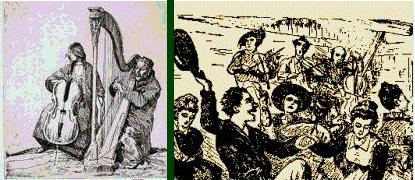Last weekend I was at a dance weekend in a lodge on Mt. Baldy. I had cause to pause and reflect on why in the world am I playing cello, and what am I trying to accomplish, and while I’m at it, what is it I appreciate about music, and admire about musicians, anyway?
Naturally, we had a live band, in this case - Bandáge à Trois, from Utah. I figure, from Friday evening to Sunday evening, they were on for at least 15 hours. When they were on, they played about 85% of the time. The remaining 15% was time when the “caller” (in olden days would be called the Dancing Master) was teaching the dance. While I was not present for all 15 hours, I was for most of it, and I never heard a tune repeated for more than one dance, and many of those tunes were quite distinctive; I would have recognized them. Tunes from all over Europe, in this case, French and Scandinavian tunes were particularly well-represented. Bourrees, branles, waltzes, jigs, reels, polkas, hambos,…. And for each tune within the dance, there was plenty of variation across repeats. A grueling test of endurance. I’m so impressed at their preparation, stamina, teamwork between musicians, teamwork with the caller, excellent tune choices for individual dances, stimulation to the dancers, and musical imagination. I’m still in awe.
That band and caller carries on a special and very challenging tradition that well predates J S Bach. I believe the adjective “classical” is more appropriate to describe what they do, than it is for a present-day so-called classical concert performance of rigidly-defined, fully-papered compositions for immense professional orchestras to silent, motionless audiences. Certainly Louis XIV would have hired this band in a heartbeat.
I wonder how much longer this sort of classical music --- much of it hundred of years old, from many countries, played by a live band, to dancers who actually go through the effort to learn and follow formally-defined steps, with partners, as part of a larger traditional music/dance community --- will survive?


